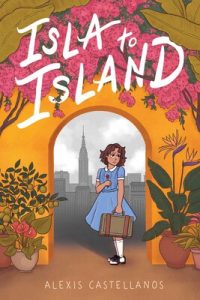 Isla to Island
Isla to Island
Written and illustrated by Alexis Castellanos
Atheneum, 2022, 192 pp
ISBN: 978-1534469235
Isla to Island is a nearly wordless graphic novel in which Alexis Castellanos tells the story of Marisol’s experience as an Operation Peter Pan child who emigrated from Cuba, her isla, to New York City, her island. As an immigrant living in an English-only speaking household, Marisol strives to learn a new language and culture and live without her beloved mother and father. The book opens with black and white photo album panels depicting Marisol’s parents, their wedding, and a baby photo of Marisol with her father—quickly followed by full color images of this young family’s life in 1958.
In Cuba, Marisol enjoys a happy life at home, in the botanical gardens, in school, and through books before the Cuban Revolution. The indoctrination and violence of the Castro regime makes Marisol’s parents fearful for their only child. With a photograph of her family and a red hibiscus flower from her father, Marisol at age ten flees from her isla and flies from Havana to the U.S. with other children leaving their families, homes, and culture. When she disembarks in New York City, Castellanos’ images are rendered in grayscale with Marisol’s red flower the only color on most pages. She is welcomed to her new island by a kind couple she appears to have never seen before. Bits of Elvis Pressley’s song “Are You Lonesome Tonight?” complete the sad, somber mood of these panels. With English also spoken exclusively at school, Marisol struggles and is bullied by classmates. Fortunately, her life begins to change when she starts her menses and finally forms a bond with her host mother.
Color creeps back into the panels when Castellanos depicts Marisol noticing the stack of books in another student’s backpack. Full color explodes on the pages when Marisol runs toward the school library and discovers books about plants. Through this connection to nature and a kindly librarian, she deals with her loneliness and being taunted at school. Readers will applaud when her host father finally takes the family to the botanical garden greenhouse—a place where Marisol feels alive.
Through the books she reads and shares, Marisol helps her host family acknowledge the cultural losses she has experienced. Her home life improves when she and her host mother cook Cuban recipes together and her host father builds her a bookcase and they hang green plants in her bedroom. Spring comes and so does a letter from Cuba. Colorful images of spring and summer show Marisol’s budding life in the city with friends and even dancing with host father. When fall comes and school begins again, Marisol overcomes her shyness and speaks for the first time in the book, “Hi, I’m Marisol.” The story ends with a series of colorful panels that show Marisol reuniting with her parents, dressed for her quinceañera, her high school graduation, at work as a teacher, and finally her own family posing with her parents on their 40th wedding anniversary in 1985. These panels are presented with photo album corners, repeating a design from the opening pages of the book.
The back matter includes a recipe from Marisol’s kitchen, information about Operation Peter Pan, and an author’s note. Castellanos provides a brief history of Cuba’s political struggles and information about Operation Peter Pan, which for two years provided visa waivers and a foster program for Cuban children. In her author’s note, Castellanos says this story was inspired by her mother’s immigrant experiences; she came to the United States through the Freedom Flights, which brought more than 175,000 Cubans to the U.S. between 1965 and 1969.
Isla to Island can be paired with other graphic novels that focus on traumatic experiences in childhood and young adulthood. In New Kid, author-illustrator Jerry Craft (2019) portrays Jordan Banks’ experiences as a seventh grader negotiating the culture of a new middle school. Jordan endures micro- and macro-aggressions as he finds his place as a Black student among his predominately white and affluent classmates. Another pairing is a graphic novel with a historical perspective, When I Grow Up: The Lost Autobiographies of Six Yiddish Teenagers by Ken Krimstein (2021), who illustrated the six essays in the book. Cultural, religious, and political threads run through their stories that illuminate these teens’ emotions and experiences with their families and friends.
Author-illustrator Castellanos was born and raised in Florida. She notes she grew up with family stories about Cuba and stories about making new lives in the U.S. When they left their isla, her relatives brought family photo albums that served as prompts for their rich and vivid storytelling.
Judi Moreillon, Tucson, Arizona
© 2022 by Judi Moreillon

WOW Review, Volume XIV, Issue 4 by Worlds of Words is licensed under a Creative Commons Attribution-NonCommercial-ShareAlike 4.0 International License. Based on work by Judi Moreillon at https://wowlit.org/on-line-publications/review/xiv-4/5
WOW review: reading across cultures
ISSN 2577-0527
